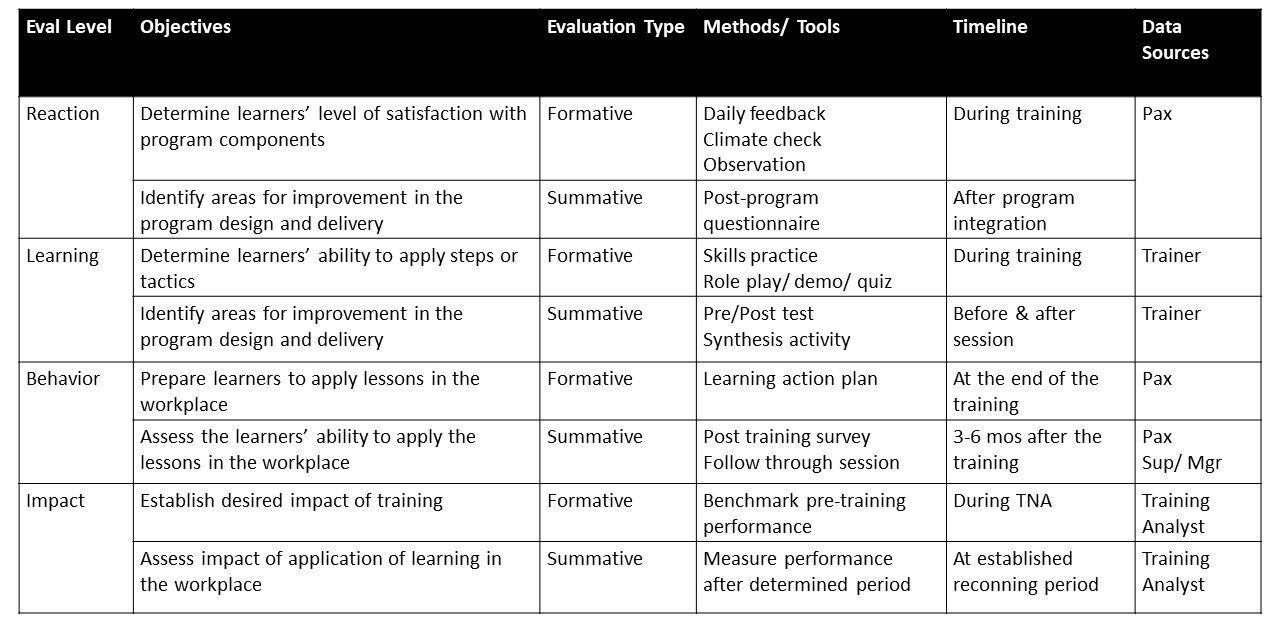Do you implement a 4-level Training Evaluation? If your answer is yes, that’s great, but do you also have a strategy for seeing to it that your training initiatives lead to a positive impact on organizational performance? The answer must also be yes. Otherwise, your training evaluation plan is reactive and neither strategic nor proactive.
When deploying the Kirkpatrick model to assess the effectiveness of training interventions, it’s not merely about post-training evaluations. For an insightful and comprehensive assessment, it’s crucial to intertwine the 4-level objectives strategy with both formative (ongoing) and summative (conclusive) evaluations. Here’s a structured approach to achieve this:
Establish Clear Outcome Objectives:
Every training journey should commence with a well-defined destination in mind. If, for instance, your goal is to boost the efficacy of the performance management system, that becomes your primary objective. A few other examples are increases in productivity, quality, customer satisfaction, issue resolution, and employee engagement.
 Determine Actionable Learner Outcomes:
Determine Actionable Learner Outcomes:
With the primary objective outlined, break it down into actionable steps your learners should perform. For example, they should:
- Communicate performance targets and expectations unambiguously
- Monitor employee performance and dispense immediate feedback
- Offer coaching to those whose performance is below par
- Assess performance impartially
- Appropriately reward, recognize, or correct performance
Design an Aligned Training Program:
Having set the objectives, sculpt your training program to provide learners with the essential knowledge and tools to implement their learnings in their professional environment. Bloom’s taxonomy provides the necessary guidance to ensure that the design of the course addresses the learning needs from knowing to creating. Using the taxonomy also aids you in using methodologies that will help you assess how much the learners are learning while in the training process.
Incorporate a 4-Level Evaluation Strategy with Formative and Summative Assessments in the training design:
Level 1: Reaction: Instead of waiting for the end, capture immediate feedback during the training. Allow participants to reflect upon and assess each session’s objectives and voice any areas of uncertainty. This real-time feedback, a key part of formative evaluations, allows for instant course corrections and ensures more efficient learning.
Ad: Let ExeQserve help you build your competency-based L&D Strategy
Level 2: Learning: Moving beyond the conventional pre and post-test approach, embed regular skills-based exercises. Such formative assessments, done throughout the training, not only captivate learners but also enable facilitators to address learning gaps right away. Examples of methodologies you can use that also allow you to assess learning are role-playing, interactive demos, simulations, problem-solving exercises, case studies, and the like. Remember, lectures don’t guarantee learning.
Level 3: Behavior: Once the training concludes, it’s time for a summative evaluation focusing on the application of the acquired knowledge in real-world scenarios. A re-entry or learning action plan serves this purpose. By obligating learners to devise and implement this plan, and by seeking approval from their superiors, you create an environment of accountability and support. At this level, the partnership between the training department and the learners’ managers in helping them apply the lessons in the workplace is crucial to the program’s success. Most efforts are doomed to fail if there is no commitment among all stakeholders in the developmental journey of the learners.
Level 4: Results: The zenith of your evaluation approach is assessing tangible outcomes. Employ specific performance indicators and meticulously track the evolution of learners. This summative evaluation will offer clear insights into whether the training resulted in the anticipated changes.
By interlacing the 4-level objectives strategy with formative and summative evaluations, you not only enrich the evaluation process using the Kirkpatrick model but also ensure that the prime focus remains undeviating – equipping learners to effectively drive organizational objectives.








